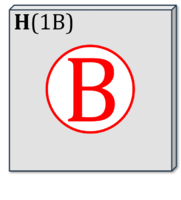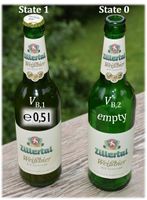Difference between revisions of "Talk:X-mass Carol"
From Bioblast
| Line 1: | Line 1: | ||
''Workin progress'' | ''Workin progress'' | ||
== Current == | |||
fraction of potentially 'true' innovations per publication is ''F''<sub>i</sub> = ''N''<sub>i</sub>/''N''<sub>p</sub>. This is the ''potential innovation efficiency'', which is very low to start with. | |||
::::# The fraction of of publications realized by actual decoding the publication media into meaning in one's mind is ''F''<sub>m</sub> = ''N''<sub>m</sub>/''N''<sub>p</sub>, or the number of meaningfully studied and understood publications is reduced from ''N''<sub>p</sub> (realization level 1) to ''N''<sub>m</sub> = ''F''<sub>m</sub>·''N''<sub>p</sub> (realization level 2) | |||
:::: These are the three variables determining the level-2 innovation efficiency ''F''<sub>m,i</sub> and number of studied and understood publications containing 'true' innovations ''N''<sub>m,i</sub>, | |||
'''Eq. 6.1a.''' Innovation efficiency level 2: ''F''<sub>m,i</sub> = ''N''<sub>m,i</sub>/''N''<sub>p</sub> = ''F''<sub>m</sub>·''F''<sub>i</sub> | |||
'''Eq. 6.1b''': Innovation realization level 2: ''N''<sub>m,i</sub> = ''F''<sub>m,i</sub>·''N''<sub>p</sub> = ''F''<sub>i</sub>·(''F''<sub>m</sub>·''N''<sub>p</sub>) | |||
:::: Control on innovation efficiency resides partially in the innovator, partially in the scientific community, and partially in the public. Control of ''F''<sub>i</sub> is largely in the hands of the innovator; but it is not that simple. How is — an undesirable goal — ''F''<sub>i</sub> minimized? The largest documented factor responsible for a low ''F''<sub>i</sub> is the high fraction of irreproducible results. As a simplification we take irreproducible results as irreproducible publications ''N''<sub>z</sub> of zero value, versus potentially valuable reprodicible publications ''N''<sub>r</sub>. Then the reproducibility efficiency ''F''<sub>r</sub> is: | |||
'''Eq. 6.2a.''' Reproducible versus zero-value publications: ''N''<sub>p</sub> = ''N''<sub>r</sub>+''N''<sub>z</sub> | |||
'''Eq. 6.2b.''' Reproducibility efficiency: ''F''<sub>r</sub> = ''N''<sub>r</sub> / ''N''<sub>p</sub> ≈ 0.2 | |||
:::: [[Ioannidis 2014 Lancet |Ioanidis et al 2014]] suggest that fraction of irreproducible results published may be even higher than 80 %, therefore, ''F''<sub>r</sub> ≈ 0.2 is an optimistic estimate. The potential number of innovations per publication is strongly controlled by ''F''<sub>r</sub>, since ''N''<sub>i</sub>/''N''<sub>z</sub> = 0, | |||
'''Eq. 6.3a.''' Innovation effect of reproducibility efficiency: ''N''<sub>i</sub> = ''F''<sub>r</sub>·''F''<sub>i</sub>·''N''<sub>p</sub> | |||
'''Eq. 6.3b.''' Realization level-2 effect of reproducibility efficiency: ''N''<sub>m,i</sub> = ''F''<sub>z</sub>·''F''<sub>i</sub>·(''F''<sub>m</sub>·''N''<sub>p</sub>) | |||
:::: ''N''<sub>m,i</sub> is a simple elementary quantity (not to be confused with an elementary entity) or a count. It's numerical value can neither be measured nor counted, it can only be calculated mathematically. The strategy of calculation is defined in '''Eq. 6.1'''. ''N''<sub>m,i</sub> is a physical potential number of m,i-publications, since it has a defined maximum value found in the real world of publications, which is obtained when setting all fractions in '''Eq. 6.1''' as equal to one, which is a theoretical standard state of maximum efficiency ''F''<sub>m,i</sub>° = 1: | |||
'''Eq. 6.2.''' Standard state: ''N''<sub>m,i</sub>° = ''N''<sub>p</sub> | |||
:::: As defined above, in the idealistic standard state, all efficiencies are 1, including ''F''<sub>z</sub>° = 1. This reduces the number of publications 'N''<sub>z</sub> of zero value but with a high count 'N''<sub>z</sub> = (1-'F''<sub>z</sub>)·'N''<sub>p</sub> ≈ 0.8·'N''<sub>p</sub> to 'N''<sub>z</sub>° = 0 x in the standard state. The present reproducibility efficience ''F''<sub>z</sub> ≈ 0.2 would have to be increased by a factor ''r''° = 5. | |||
:::: Strategies to maximize ''N''<sub>m,i</sub> are complex and depend on baseline conditions. Every spending of public funds, donations, company investments, and personal resources should reflect and disclose the MiP strategy persued, even in the face of a high probability that there may exist multiple optimization strategies leading to similarly low maximum values of ''N''<sub>m,i</sub>. | |||
:::: Consequently, there are two opposite strategies to increase ''N''<sub>m,i</sub> to a higher value ''N''<sub>m,i</sub>* in a new reference state, (''1'') to increase the real-world standard number of publications ''N''<sub>p</sub> at high costs to ''N''<sub>p</sub>*, or (''2'') optimize the efficiency on all levels expressed as fractions in '''Eq. 6.1.''' to the new values of ''F''<sub>i</sub>* and ''F''<sub>m</sub>*. It is an affordable simplification to restrict the analysis to efficiencies with maximum values of one, while ignoring efficacies of ''F''<sub>i</sub> which can theoretically assume a value ''F''<sub>i</sub> > 1, if there are multiple innovations i per number of publications ''N''<sub>p</sub>. This is not fair to the supergenius, but rare enough to justify the simplification. | |||
:::: First, a static MiP model of innovation values is analyzed, where the capacity of publication media and the investments into R&D are fixed. The dynamic MiP model acknowledges the fact, that the capacity of the publication media increases over-exponentially, leading to a super-exponential increase of the number of publications. | |||
=== The static MiP model === | |||
:::: The present capacity of the publication media is saturated, which means that more manuscripts are submitted than are published. The number of publications ''N''<sub>p</sub> is fixed, therefore, in the static MiP model, where no additional publication media are opened. | |||
:::: A realistic target for measures to be taken to increase reproducibility may be ''r''* = 2, to double 'F''<sub>z</sub> to a reference efficiency of 'F''<sub>z</sub>* = 0.4. Then the present number of zero-value publications would decrease by ''N''<sub>z</sub>-''N''<sub>z</sub>* = (''r''*-1)·''F''<sub>z</sub>·''N''<sub>p</sub>. For ''F''<sub>z</sub> = 0.2 and ''r''* = 2, 20 % of total publication costs would be saved. | |||
:::: The number of publications ''N''<sub>m</sub> that are read and understood (mentally realized) is the term in parentheses in '''Eq. 6.4b''' (''F''<sub>m</sub>·''N''<sub>p</sub>). If the time available for critically reading, understanding and evaluating the available publications is limiting, ''i.e.'', if the availability of publications is not limiting, then ''N''<sub>m</sub> is constant at a maximum value ''N''<sub>m</sub> = ''N''<sub>m</sub>(max). | |||
== Updates == | == Updates == | ||
Revision as of 06:55, 18 July 2020
Workin progress
Current
fraction of potentially 'true' innovations per publication is Fi = Ni/Np. This is the potential innovation efficiency, which is very low to start with.
- The fraction of of publications realized by actual decoding the publication media into meaning in one's mind is Fm = Nm/Np, or the number of meaningfully studied and understood publications is reduced from Np (realization level 1) to Nm = Fm·Np (realization level 2)
- These are the three variables determining the level-2 innovation efficiency Fm,i and number of studied and understood publications containing 'true' innovations Nm,i,
Eq. 6.1a. Innovation efficiency level 2: Fm,i = Nm,i/Np = Fm·Fi Eq. 6.1b: Innovation realization level 2: Nm,i = Fm,i·Np = Fi·(Fm·Np)
- Control on innovation efficiency resides partially in the innovator, partially in the scientific community, and partially in the public. Control of Fi is largely in the hands of the innovator; but it is not that simple. How is — an undesirable goal — Fi minimized? The largest documented factor responsible for a low Fi is the high fraction of irreproducible results. As a simplification we take irreproducible results as irreproducible publications Nz of zero value, versus potentially valuable reprodicible publications Nr. Then the reproducibility efficiency Fr is:
Eq. 6.2a. Reproducible versus zero-value publications: Np = Nr+Nz Eq. 6.2b. Reproducibility efficiency: Fr = Nr / Np ≈ 0.2
- Ioanidis et al 2014 suggest that fraction of irreproducible results published may be even higher than 80 %, therefore, Fr ≈ 0.2 is an optimistic estimate. The potential number of innovations per publication is strongly controlled by Fr, since Ni/Nz = 0,
Eq. 6.3a. Innovation effect of reproducibility efficiency: Ni = Fr·Fi·Np Eq. 6.3b. Realization level-2 effect of reproducibility efficiency: Nm,i = Fz·Fi·(Fm·Np)
- Nm,i is a simple elementary quantity (not to be confused with an elementary entity) or a count. It's numerical value can neither be measured nor counted, it can only be calculated mathematically. The strategy of calculation is defined in Eq. 6.1. Nm,i is a physical potential number of m,i-publications, since it has a defined maximum value found in the real world of publications, which is obtained when setting all fractions in Eq. 6.1 as equal to one, which is a theoretical standard state of maximum efficiency Fm,i° = 1:
Eq. 6.2. Standard state: Nm,i° = Np
- As defined above, in the idealistic standard state, all efficiencies are 1, including Fz° = 1. This reduces the number of publications 'Nz of zero value but with a high count 'Nz = (1-'Fz)·'Np ≈ 0.8·'Np to 'Nz° = 0 x in the standard state. The present reproducibility efficience Fz ≈ 0.2 would have to be increased by a factor r° = 5.
- Strategies to maximize Nm,i are complex and depend on baseline conditions. Every spending of public funds, donations, company investments, and personal resources should reflect and disclose the MiP strategy persued, even in the face of a high probability that there may exist multiple optimization strategies leading to similarly low maximum values of Nm,i.
- Consequently, there are two opposite strategies to increase Nm,i to a higher value Nm,i* in a new reference state, (1) to increase the real-world standard number of publications Np at high costs to Np*, or (2) optimize the efficiency on all levels expressed as fractions in Eq. 6.1. to the new values of Fi* and Fm*. It is an affordable simplification to restrict the analysis to efficiencies with maximum values of one, while ignoring efficacies of Fi which can theoretically assume a value Fi > 1, if there are multiple innovations i per number of publications Np. This is not fair to the supergenius, but rare enough to justify the simplification.
- First, a static MiP model of innovation values is analyzed, where the capacity of publication media and the investments into R&D are fixed. The dynamic MiP model acknowledges the fact, that the capacity of the publication media increases over-exponentially, leading to a super-exponential increase of the number of publications.
The static MiP model
- The present capacity of the publication media is saturated, which means that more manuscripts are submitted than are published. The number of publications Np is fixed, therefore, in the static MiP model, where no additional publication media are opened.
- A realistic target for measures to be taken to increase reproducibility may be r* = 2, to double 'Fz to a reference efficiency of 'Fz* = 0.4. Then the present number of zero-value publications would decrease by Nz-Nz* = (r*-1)·Fz·Np. For Fz = 0.2 and r* = 2, 20 % of total publication costs would be saved.
- The number of publications Nm that are read and understood (mentally realized) is the term in parentheses in Eq. 6.4b (Fm·Np). If the time available for critically reading, understanding and evaluating the available publications is limiting, i.e., if the availability of publications is not limiting, then Nm is constant at a maximum value Nm = Nm(max).
Updates
- The term unit-entity UX is changed to elementary entity UX.
- The term experimental chamber is equivalent to experimental system.
X-files unit
Quotes
- Mulder: We've both lost so much... but I believe that what we're looking for is in the X-Files. I'm more certain than ever that the truth is in there. Scully: I've heard the truth, Mulder. Now what I want are the answers.
- Scully: The Truth is out there, Mulder. But so are lies.
- Tad O'Malley: If I'm going to put my ass out there, I need to know if it's hanging by a thread.
- Mulder: Sometimes the only sane answer to an insane world is insanity.
- Reverend Finley: Sometimes we must come full circle to find the truth. Why does that surprise you? Scully: Mostly, it just makes me afraid. Reverend Finley: Afraid? Scully: Afraid that God is speaking... but that no one's listening.
- Mulder: You know, they say when you talk to God it's prayer, but when God talks to you, it's schizophrenia.
- Mulder: You have to be willing to see. Scully: I wish it were that simple. Mulder: Scully, you have to believe me. Nobody else on this whole damn planet does or ever will. You're my one in five billion.
- Scully: You have seen this before, I can tell. You lied to them. — Mulder: I would never lie. I willfully participated in a campaign of misinformation.
- Deep Throat: And a lie, Mr. Mulder, is most convincingly hidden between two truths.
- Mulder: What can I do about a Lie with an Official Seal on it?
- Melissa Scully: Why is it so dark in here? Mulder: The lights aren't on.
- Mulder: I've often felt that dreams are answers to questions we haven't yet figured out how to ask.
- Scully: I have never met anyone so passionate and dedicated to a belief as you. It's so intense that sometimes it's blinding.
2 B or not 2 B
The medium is the message: Bottle or Beer
Canon N: Can you drink a volume? The Beer is the message, not the Bottle
- The bottle is full of fullness or full of emptyness
- SP is very thursty after a long run. Here is a nice and cold Bottle of Beer. She opens the Bottle and intends to drink the whole volume VB. CH interfers by stating accurately, that you cannot drink a volume. Since SP does not understand but is still thursty, MP explains by a long canonical monologue, presenting an example.
- MP: Here is my Bottle of beer, which I emptyied just before you arrived. My bottle has an internal volume VGB of slightly more than 0.5 L, since it contains a volume VB
| External container | Symbol | Contents | Symbol |
|---|---|---|---|
| Glass bottle | GB | Glass bottle | GB |
| Example | Example | Example | Example |
| Example | Example | Example | Example |
| M || MitoEAGLE states and rates — a coral on canonical and practical |-
Canon M: MitoEAGLE states and rates and mitochondrial physiology — a coral on canonical and practical
Canon C: A pzzle on pine Cones
Bits
- Voice O Table 1. Towards Table H10
Speaker Symbol Speaked What Sport scientist S ??? .. We need more Beers. One per B on our table A. Example Chemist C How many moles of B? - {They get 6 Beers} Example Sport scientist S Don't push down to the unit mole for amount, let's stick to the count. I count NB = 6 Beers in our system A, and NB = 6 Bodies; divide the Beers by the Bodies, then you have one. Example Chemist C You forgot the units. Example Sport scientist S Who cares about units? Beer is Beer, Body is Body. Example Mitochondrial biologist M Only when you count, not when you measure mass or volume. My Weizen is a 0.5 L beer, your Pils is a 0.33 L beer. Example # # # Example
- Chemist C: According to SI, you should use Base SI units, to express volume in the unit [m-3].
- Mitochondrial biologist M: We are practical and use the liter [L]. I don't care about [m3].
- Sport scientist S: Now it is me who cares. Since we express the BMI in SI units [kg·m-2], this normalization for Area [m3] is closer to [m3] than to [L].
- Chemist C: But this is trivial, 1 L = 1 dm3. And one mole ..
Before she contemplates on how many liters of Beer per B have been consumed



